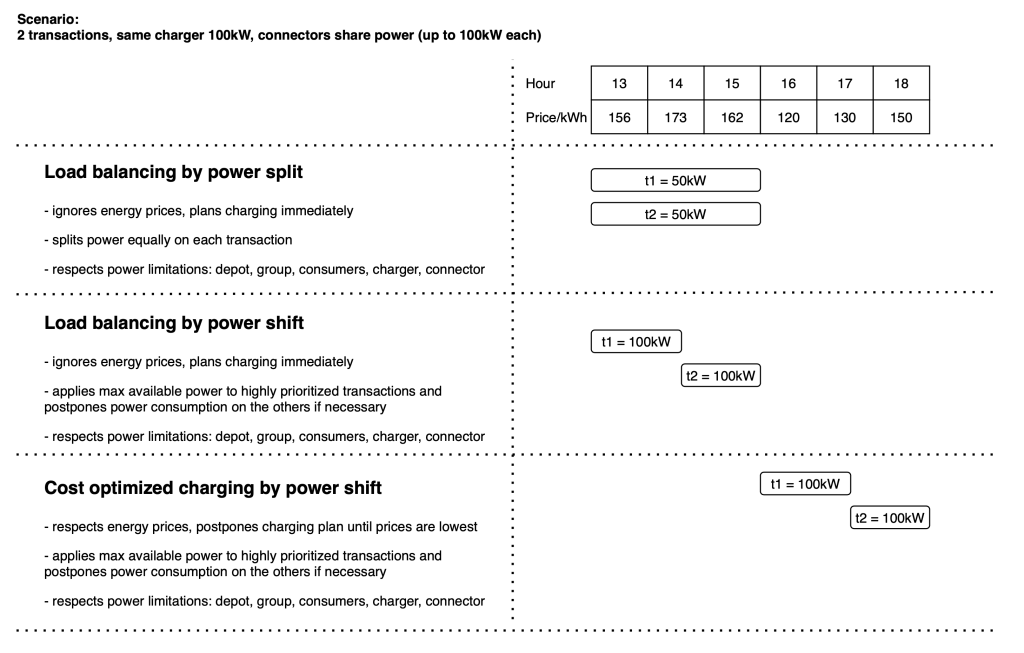As electric fleets grow, managing energy becomes as important as managing vehicles. Charging dozens or even hundreds of buses or trucks at once can strain grid capacity and increase costs if not carefully controlled. Load balancing ensures that energy is distributed efficiently across all chargers so vehicles are always ready when needed, without overloading the grid or wasting power.
Understanding Load Balancing
Load balancing in electric fleets means distributing available charging power intelligently so that no single charger or circuit is overloaded while others sit idle. It keeps energy use stable, maximises infrastructure efficiency, and helps operators make the most of available grid capacity.
The “Load Balancing by Power Split” scenario illustrates the simplest approach: when several vehicles are charging simultaneously, available power is divided evenly among them. This ensures equal energy distribution across all active chargers and prevents overloads at the depot.
In more advanced setups, such as “Load Balancing by Power Shift”, charging power is not split evenly but dynamically allocated based on vehicle priority. Vehicles that must depart sooner receive more power, while others charge more slowly or temporarily pause.
Finally, “Cost-Optimised Charging by Power Shift” adds a financial dimension. The system applies the same dynamic prioritisation but aligns it with real-time energy pricing. Charging is automatically shifted to periods when electricity rates are lower, reducing operational costs while maintaining vehicle readiness.

Why Load Balancing Matters
Optimised Energy Usage
Electric buses and trucks draw significant power during charging. Without control, simultaneous charging can overwhelm the grid. Load balancing distributes energy across available chargers, keeping demand stable and ensuring every vehicle receives sufficient charge without exceeding the site limit.
Cost Efficiency
Electricity prices fluctuate based on demand and time of day. According to Eurostat, peak rates in the EU can be up to 50 percent higher than off-peak rates. Through cost-optimised power shifting, Tenix systems automatically prioritise charging during low-tariff hours, reducing total energy costs by up to 25 percent.
Enhanced Vehicle Availability
Fleet reliability depends on having vehicles charged and ready when required. Load balancing by power shift ensures that vehicles with early departures receive priority, while those parked longer are scheduled later. This dynamic control improves operational readiness and prevents missed routes.
Strategies for Effective Load Balancing
1. Smart Charging Systems
Smart charging technology is essential for load balancing across multiple chargers. Tenix Charge continuously monitors grid conditions, vehicle state of charge, and energy prices. The system automatically redistributes power to ensure optimal use of available capacity while keeping costs low and vehicles ready for service.
2. Route and Schedule Integration
Charging efficiency depends on how well it aligns with daily operations. With Tenix Fleet, managers can coordinate charging schedules with actual routes and driver shifts. This integration ensures that vehicles are charged at the right time and place, avoiding unnecessary energy consumption or downtime.
3. Demand Response Participation
Many utilities reward fleets that adjust energy use during peak grid demand. By participating in demand response programs, operators can pause or reduce charging when the grid is under stress, then resume when capacity and pricing improve. Tenix integrates directly with these programs, helping fleets save money while supporting a more stable power network.
4. Integration with Renewable Energy
Fleets that generate or purchase renewable energy can further enhance load balancing. Tenix systems can schedule charging around renewable output, for instance aligning depot charging with midday solar production. This reduces reliance on grid electricity and strengthens sustainability performance.
A Real Example of Load Balancing in Action
At a large Scandinavian depot operating over 100 electric buses, Tenix software monitors total grid capacity and dynamically allocates power across chargers. During peak operation, the system follows the Power Split principle to ensure fairness, while applying Power Shift rules to prioritise vehicles due to depart first.
When energy prices rise sharply, cost-optimised charging shifts power to later hours when tariffs are lower. As a result, the operator reduced monthly energy bills by more than 20 percent, eliminated grid overload incidents, and maintained consistent on-time departures.
Efficiency That Powers Sustainability
Load balancing is a cornerstone of efficient and sustainable electric fleet management. It keeps depots stable, reduces costs, and ensures that every vehicle is ready when it needs to be.
Tenix Charge automates this entire process. By combining live energy data, operational schedules, and grid capacity limits into one intelligent platform, it ensures that charging happens at the right time, with the right power, at the lowest possible cost.
As electrification expands across Europe, effective load balancing will be what separates efficient fleets from inefficient ones. Tenix helps operators stay in control by turning complex energy data into simple, automated charging decisions that keep fleets running smoothly and sustainably.




